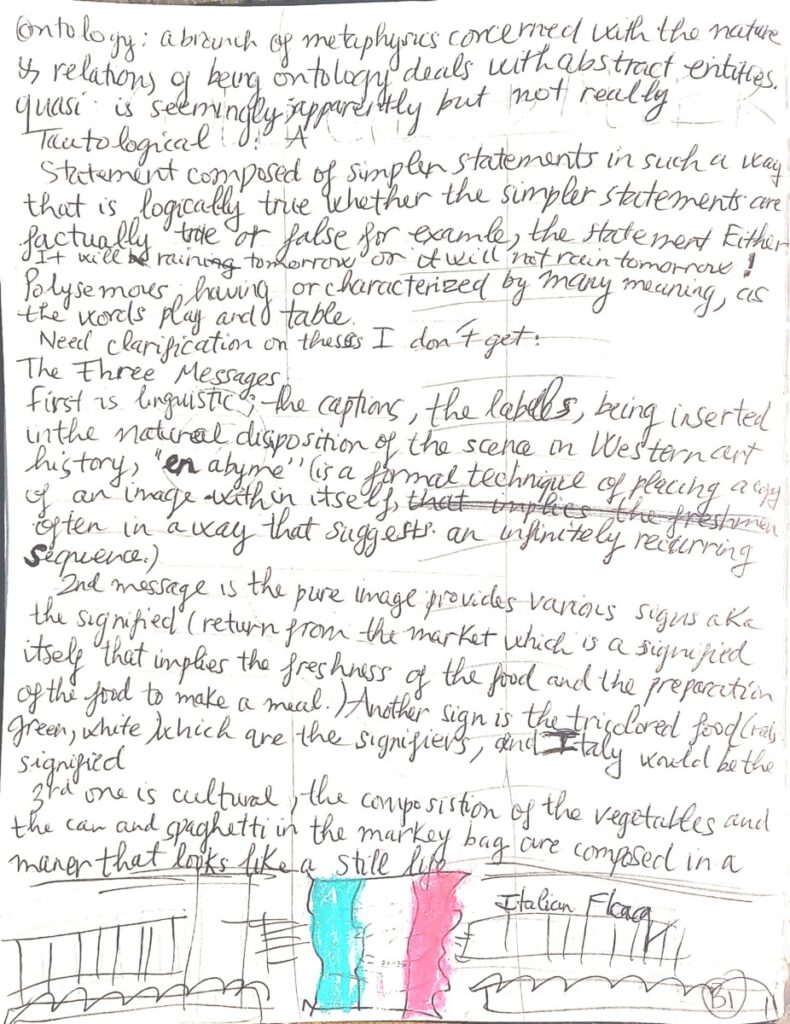When taking a look at the reading, there has been several terms of words that I haven’t fully understand, however, I was able to look them up and try to paraphrase it to better understand the meaning behind it. Other then that, the reading wasn’t too much of a burden to deal with.
Month: April 2022 (Page 5 of 5)
Terms
Tautological
Syntagm
conotation means to point toward something
denotation is its literal meaning.
Analysis
Barthes explains that when words accompany an image the image loses its freedom to be interpreted. the image is a slave to the text that accompanies limiting the interpreters ability to ascribe meaning where there may be none, or to ascribe a separate meaning altogether.
When an image contains words, it requires you at the very least to know how to read the words within the image to understand its meaning.
Advertising contains no literal images as it’s advertising’s job to point at greater meaning.
At its barest state the meaning of an image is exactly what it is. Meaning at its very core an image has at least one meaning.
Photograph representing the here and now and the there and then is interesting.
The literal image is the basis of the symbolic image.
The more technology we develop to view and create images the easier it is to hide the true meaning of those images under the literal image.
Key Words
- imitari
- image
- seismology
- code
- denotation
- denotational
- cannotational
- signifier
- composition
- alimentary
- coextensive
- linguistic
- dispatching
- puedo-truth
- ideolect
Questions
- I wasn’t too clear on what the author was trying to say with the word “italianicity”?
- “We can now understand that it is precisely the syntagm of the denoted message which “naturalizes” the system of the cannoted message”. In this i wasn’t sure if he viewed this aspect as a positive or negative.
In Roland Barthes’ “Rhetoric of the Image” essay, he explains how images hold and convey meaning through three messages, linguistic message, non-iconic decoded message and coded iconic message. Signs, signifiers, and signified are used within images as a written language to help communicate the message. Barthes simplified the science of advertising, breaking down the three messages. We understand this information because of our cultural awareness, social and personal experiences. Looking at the image a product or service advertisement content is used to explain the message.
Many different understandings and questions come to mind when I read Roland Barthes’ article titled “Rhetoric of the Image”, especially with how it looks into the concept of images and meanings within or around it.
What is interesting is how the article discusses Linguistics in terms of how a message within images are read. As well as how signs are utilized as well. Is it the image itself that gives the message, or a combination of other factors such as texts that does so instead? And could there be multiple meanings behind an image, or just a limit amount of possibilities. And could these questions aldo be attributed with how some designs are made in the modern era?
Words I don’t know:
- semiology
- agglutinations
- ineffable
- ontology
- en abyme
- assonance
- insofar
- arbitrary
- quasi-tautological
- anchorage
- polysemous
Did not quite understand:
- We know that linguists refuse the status of language to all communication” by analogy-from the “language” of bees to the “language” of gesture – the moment such communications are not doubly articulated, are not founded on a combinatory system of digital units as phonemes are.
- This last information, however, is co-extensive with the scene; it eludes signification insofar as the advertising nature of the image is essentially functional: to utter something is not necessarily to declare t am speaking, except in a deliberately reflexive system such as literature.





Recent Comments